The Intel Skylake Mobile and Desktop Launch, with Architecture Analysis
by Ian Cutress on September 1, 2015 11:05 PM ESTThe Claims
As with any launch, there are numbers abound from Intel to explain how the performance and experience of Skylake is better than previous designs as well as the competition.
As with Haswell and Broadwell, Intel is implementing a mobile first design with Skylake. As with any processor development structure the primal idea is to focus on one power point as being the most efficient and extend that efficiency window as far in either direction as possible. During IDF, Intel stated that having an efficiency window from 4.5W to 91W is a significant challenge, to which we agree, as well as improving both performance and power consumption over Broadwell at each stage.
Starting at 4.5W, we spoke extensively with parts of Intel at IDF due to our Broadwell-Y coverage. From their perspective Broadwell-Y designs were almost too wide ranging, especially for what is Intel’s premium low-power high performance product, and for the vendors placing it in an ill-defined chassis far away from Intel’s recommended designs gave concern to the final performance and user experience. As a result, Intel’s guidelines to OEMs this generation are tightened so that the designers looking for the cheaper Core M plastic implementations can tune their design to get the best out of it. Intel has been working with a few of these (both entry Core M and premium models) to enact the user experience model.
Overall however, Intel is claiming 40% better graphics performance for Core M with the new Generation 9 (Gen9) implementation, along with battery saving and compatibility with new features such as RealSense. Because Core-M will find its way into products from tablets to 2-in-1s and clamshells, we’ve been told that the Skylake design should hit a home-run against the best-selling tablets in the market, along with an appropriate Windows 10 experience. When we get units in to review, we will see what the score is from our perspective on that one.
For the Skylake-Y to Skylake-U transition (and in part, Skylake-H), Intel is claiming a 60% gain in efficiency over Haswell-U. This means either 60% less active power during media consumption or 60% more CPU performance at the same power (measured by synthetics, specifically SPECint_base_rate2006). The power consumption metrics comes from updates relating to the Gen9 graphics, such as multi-plane overlay and fixed-function decoders, as well as additional power/frequency gating between the unslice and slices. We will cover this later in the review. The GPU itself, due to the new functionality, is claiming 40% better graphics performance for Core M during 3DMark synthetic tests.
While not being launched today, Intel’s march on integrated graphics is also going to continue. With the previous eDRAM parts, Intel took the crown for absolute IGP performance from AMD, albeit being in a completely different price band. With Skylake, the introduction of a 4+4e model means that Intel’s modular graphics design will now extend from GT1 to GT4, where GT4e has 72 execution units with 128MB of eDRAM in tow. This leads to the claim that GT4e is set to match/beat a significant proportion of the graphics market today.
Back in our Skylake-K review, we were perhaps unimpressed with the generational gain in clock-for-clock performance, although improved multi-threading and frequency ranges helped push the out-of-the-box experience. The other side of that performance is the power draw, and because Skylake is another mobile-first processor, the power aspect becomes important down in mobile devices. We will go through some of these developments to improve power consumption in this article.


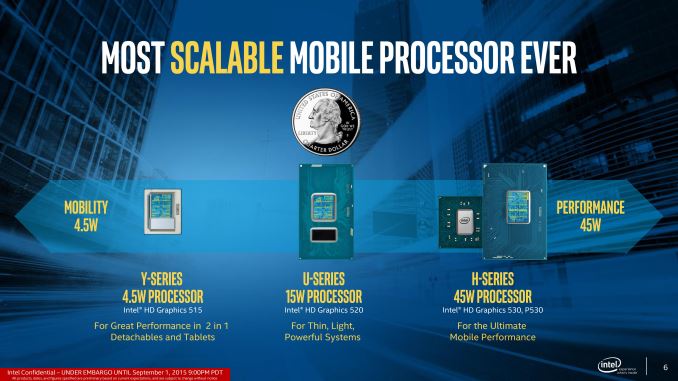
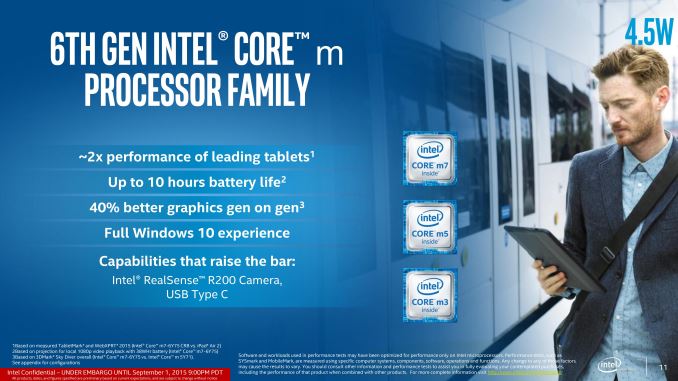
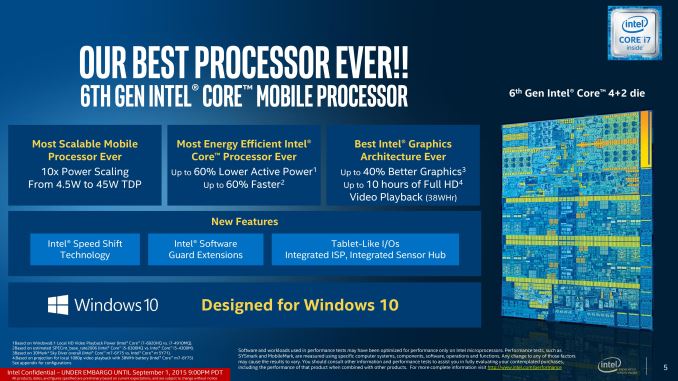
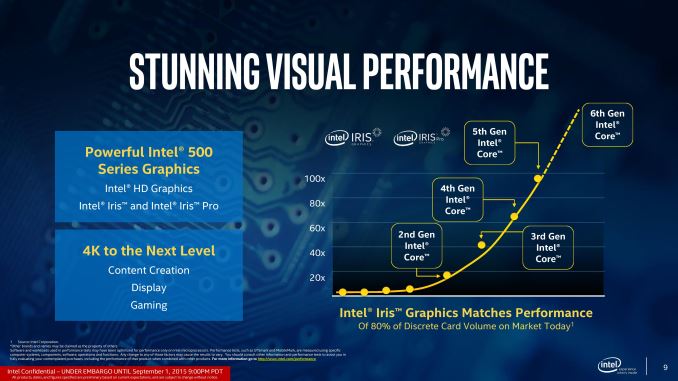
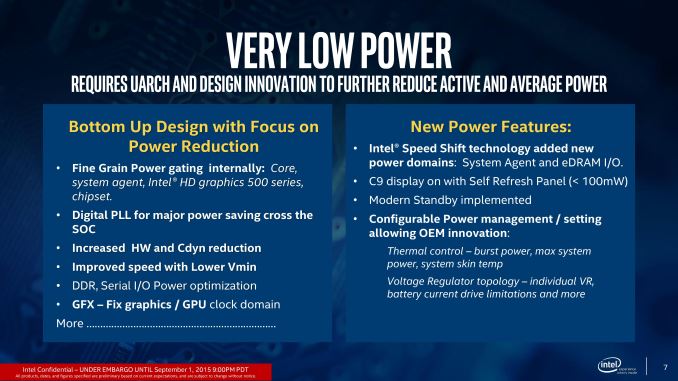








173 Comments
View All Comments
extide - Wednesday, September 2, 2015 - link
Not really, they use GCN stuff, which yes is in AMD APU's but the implementation in PS4/XBO are much larger than the ones in APU's and much closer to the ones in discreet cards.tipoo - Friday, September 4, 2015 - link
All I said was it comes close to it iin raw Gflops on the GPU. Wow the reading ability of some people.masouth - Friday, September 4, 2015 - link
Unfortunately, reading comprehension is not the strong suit of the average thread troll. You can couch something in caveats all day and some fool will come along and run off ranting or name calling regarding something that you already covered or that was not even part of what you said.MapRef41N93W - Friday, September 4, 2015 - link
AMD better IGPU? LOL. The 7870k gets slaughtered by Broadwell Iris-Pro and Skylake is offering up to 50% more performance. AMD were officially made irrelevant in the only market they even had left (APUs) this year.MapRef41N93W - Friday, September 4, 2015 - link
And the proof is right here on this very site http://anandtech.com/bench/product/1497?vs=15007870k losing by 20-30% on average vs Broadwell i5 in iGPU tests.
MapRef41N93W - Friday, September 4, 2015 - link
Inb4 the AMD shill starts bringing up the price difference like the only reason you buy a CPU is for the iGPU.FourEyedGeek - Wednesday, September 9, 2015 - link
The 7870 in a PlayStation 4 isn't that powerful, wasn't on release and certainly isn't now.InquisitorDavid - Saturday, September 12, 2015 - link
More expensive, yes.But haven't you heard? Broadwell's Iris Pro already surpassed AMD APU graphics performance. Couple that with CPU performance that AMD can't touch at this time means it's already better in all other aspects, except price.
Notmyusualid - Wednesday, September 2, 2015 - link
Nonsense.Pissedoffyouth - Wednesday, September 2, 2015 - link
this is a big deal for me, building the most compact mini PC's to hide behind my monitor and play at 1080P.